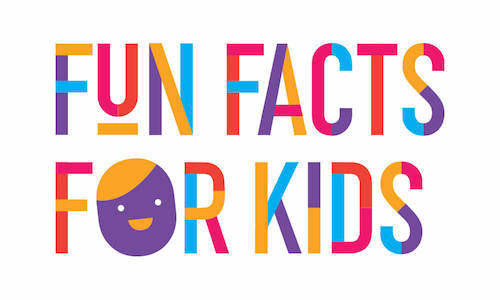Looking for fun dolphin facts for kids for a school project or just because you love dolphins and love learning facts about animals? We’ve got you covered in this article as it’s packed with useful information about dolphins.
Facts about dolphins for kids
Dolphins are known as the brainiacs of the oceans. They are super smart and have highly developed brains that have developed over thousands of generations.
Did you know that the scientific name for dolphins (or ‘toothed whales’ as they are also known) is Delphinidae? This comes from the Latin word ‘Delphinus’ which means ‘dolphin’.
Dolphins live in temperate and tropical waters around the globe, including our own coastal water of Australia. These remarkable creatures are very intelligent and playful and they’re a joy to watch. Have you ever been on a boat trip and seen dolphins playing in the waves and showing off?
Let’s answer some of your questions all about dolphins…
Are dolphins fish and how do dolphins breathe?
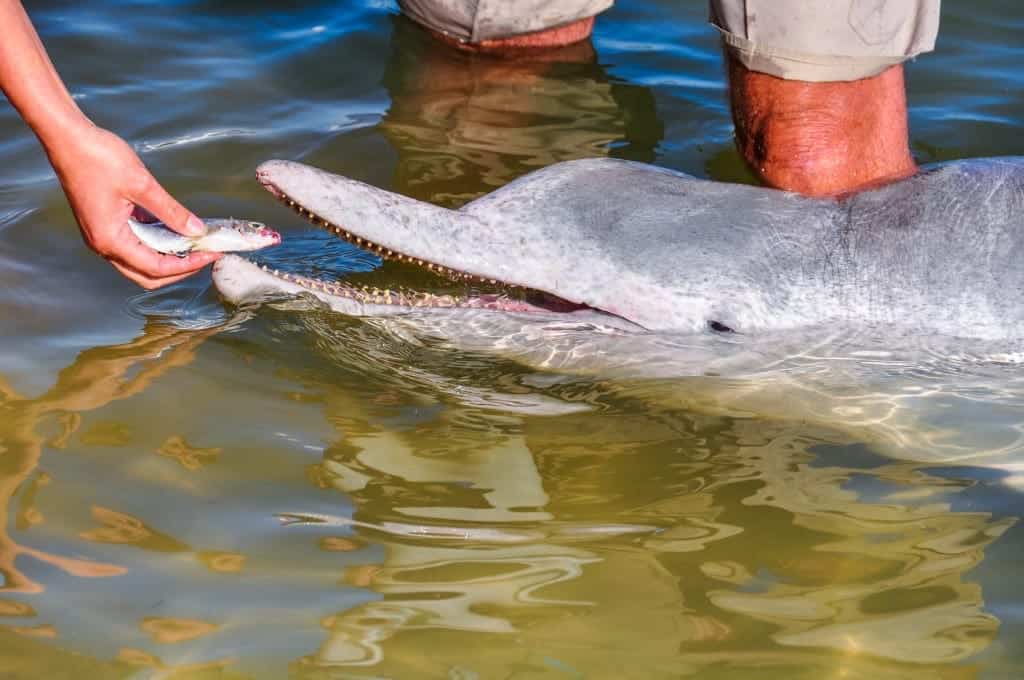
No, dolphins are marine mammals, not fish.
Dolphins are warm-blooded and they breathe through their lungs. This means they need to surface to take a breath, unlike fish which breathe underwater through their gills.
Dolphins are very clever though and they’re able to adjust their bodily functions to extend their time under water. If they need to be without breath for longer, they’re able to shut off or slow down their digestive system, heart rate, and even their blood flow to give them more time underwater.
Us humans breathe automatically without even thinking and we have to continue breathing all the time. Dolphins have a lot more control over how often they breathe so they can consider their surroundings and choose how often to surface.
While we take our breaths through our nose and mouth, dolphins only breathe through their blowhole – this is a hole on the top of their head. This hole opens to allow them to take in oxygen, and then it closes again tightly to stop water from getting in. This means a dolphin’s mouth is used purely for eating. The reason for this is so a dolphin won’t accidentally suck water into their lungs while eating so it keeps them safe from drowning.
Check out these cute dolphin stickers you can use on your school project!
How do dolphins communicate with one another?
Dolphins communicate with one another by making a squeaking, whistling, buzzing and clicking sound and every dolphin sounds unique. Their sounds can be heard by their species from miles away, so it’s a great communication tool.
How do dolphins navigate?
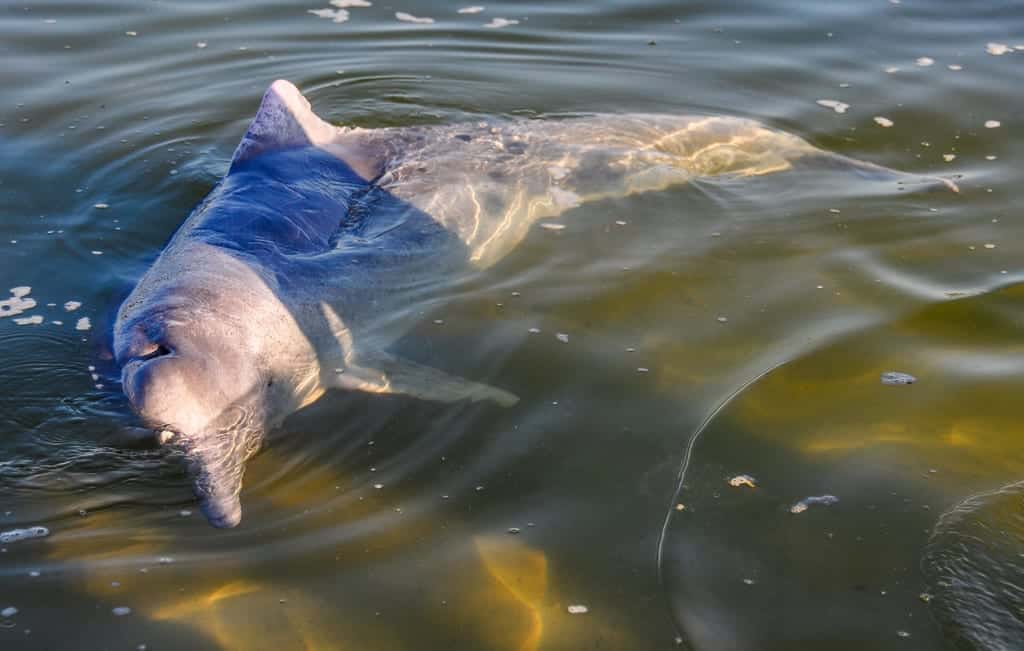
The sounds dolphins make also help them navigate and understand their surroundings. This is known as ‘echolocation’ which means ‘seeing with sound’. The soundwaves from their clicks hit the object and bounce back. This allows them to determine how close the object is, how big it is and even what it’s made of. It’s very clever! While dolphins do have eyes, water can be murky making it difficult to see so this unique ability helps them find their way around the ocean, hunt their prey and avoid danger.
Dolphins also use their bodies and fins to splash the surface of the water as a way of communicating. They use these splashes in lots of ways to communicate with the dolphins in their immediate surroundings.
Do dolphins live in groups?
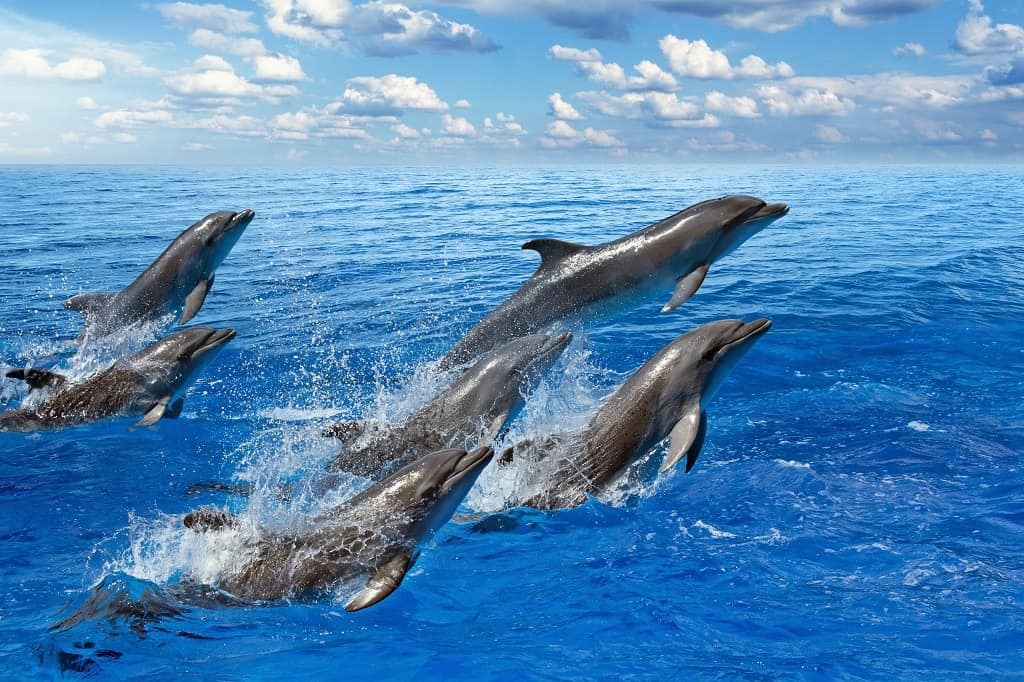
Dolphins live in groups which are called pods. Living in groups like this gives them protection, plus dolphins are social creatures and they like company so they enjoy playing together.
Living in a group allows them to hunt together as a team and their pod helps to keep them safe from predators such as sharks.
Some dolphins stay in the same area for their whole lives while others migrate to different places.
Do dolphins have teeth?
Yes, dolphins do have teeth. Dolphin teeth last them a lifetime – they only get one set! Dolphins use their teeth to catch their prey but don’t actually chew with them as they swallow their food whole.
Do dolphins have hair or do dolphins have fur?
If you’re wondering does a dolphin have hair? The answer is yes, dolphins have hair or a few whiskers when they’re born although this falls out soon after birth. Some river species do retain some whiskers into adulthood though as it can help them search for prey on the river bed as the water can be murky and the hairs (along with their clicks) can help them find food.
How do dolphins sleep?
Dolphins go to sleep by resting quietly on the surface of the water either horizontally or vertically, and they can also doze while slowly swimming alongside other dolphins.
Fun dolphin facts for kids
Let’s dive right into these fascinating and fun dolphin facts for kids:
- There are 42 species of dolphin in the world.
- Dolphins can swim very fast. Some species can go as fast as 55kmph.
- While most dolphins are grey in colour, some species have patterns of black and white. There are even some species of pink dolphins!
- Dolphins need air to breathe, but they can hold their breath a lot longer than you or I! They can hold their breath underwater for an incredible 8 to 20 minutes, depending on the species. This allows them to dive down deep to catch fish.
- Dolphins eat a variety of fish, squid and crustaceans.
- Dolphins are known to sometimes gather in ‘superpods’ which are huge gatherings of pods of dolphins. These can sometimes include up to 1000 dolphins. Think of it like a big party where they play and then disperse with their own pods again at the end of it.
- A dolphin’s pregnancy can last between nine and 16 months. Dolphins give birth to their young tail first.
- Dolphins produce milk for their calves which they drink underwater. Dolphin mums take care of their young and nurture them for years so they become independent.
- The life span of a dolphin varies across the breeds, with some living around 20 years and other species living to 80 or more.
- While most dolphins live in the oceans, there are also some freshwater dolphins that live in rivers including the Amazon and Ganges.
- Dolphins eat fish whole – they swallow them headfirst so the spines don’t catch in their throat.
- Did you know that orca (killer whales) are actually the biggest member of the dolphin family? These grow up to an epic 9m long and they live for 30 – 50 years.
- Dolphins can blow bubbles on the surface of the water. It’s a way for them to encourage their prey to the surface while hunting as this makes them easier to catch.
Check out these awesome dolphin posters for kids!
What threats do dolphins face?
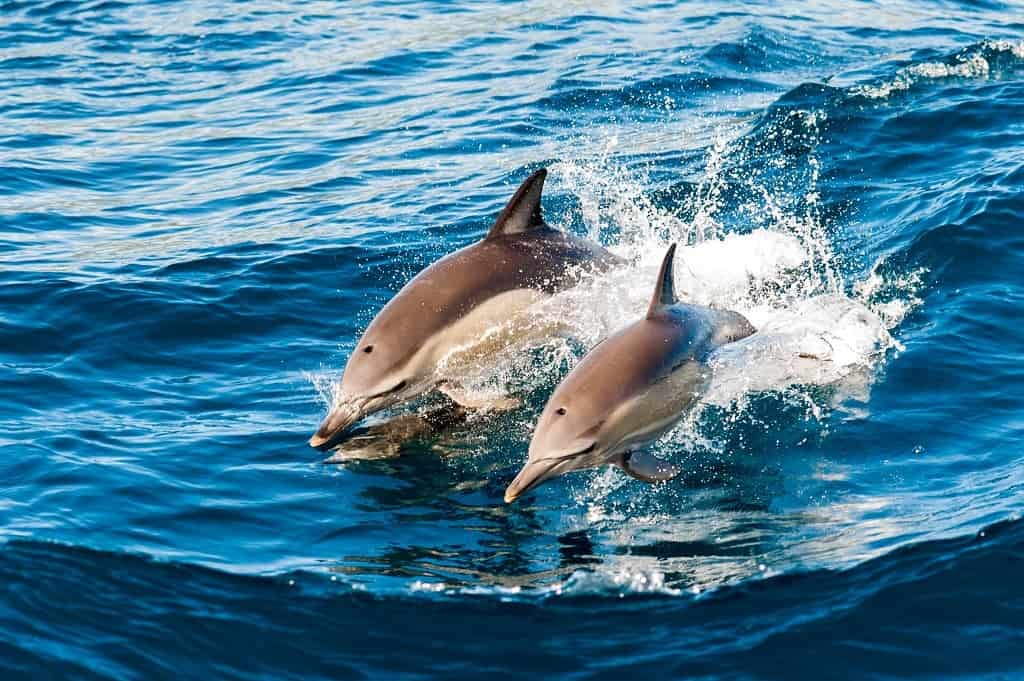
While dolphins don’t have many natural predators they, unfortunately, face many threats from humans.
Dozens of species of dolphin are endangered.
Here are some of the main threats dolphins face:
- Being caught in large nets set to catch fish
- Getting tangled in discarded fishing lines and hooks
- Pollution
- Climate change
- Overfishing
- Habitat loss through development
- Hunting
- Boat collisions
- Noise pollution (as their hearing is so sensitive so things like shipping sonars and seismic testing can cause huge issues)
We can have an impact on the future of dolphins in the world by:
- Reducing household waste
- Keeping our beaches clean
- Reducing carbon emissions
- Following marine safety rules
- Supporting conservation projects
- Recycling our waste
- Not dropping litter
- Donating to marine conservation organisations
- Educating others about the threats to dolphins
If you want to learn more about dolphins, check out the range of dolphin books here.
Fun dolphin facts for kids
I hope you enjoyed these fun dolphin facts for kids!
If you found this post about facts for kids about dolphins useful, please give it a share.
More facts for kids
If you have enjoyed these kids’ facts about dolphins and you are looking for more great facts for kids to help with projects, check out our articles:
Animal facts for kids
- Quokka Facts for Kids
- Ant Facts for Kids
- Crocodile Facts for Kids
- Echidna Facts for Kids
- Bee Facts for Kids
- Australia’s Deadliest Animals Facts for Kids
- Cheetah Facts for Kids
- Endangered Animals Facts for Kids
- Kangaroo Facts for Kids
- Possum Facts for Kids
- Koala Facts for Kids
- Dog Facts for Kids
- Cat Facts for Kids
- Butterflies Facts for Kids
- Dingo Facts for Kids
- Turtle Facts for Kids
- Penguin Facts for Kids
- Whale Facts for Kids
- Wolf Facts for Kids
- Sustainability Facts for Kids
- Recycling Facts for Kids
